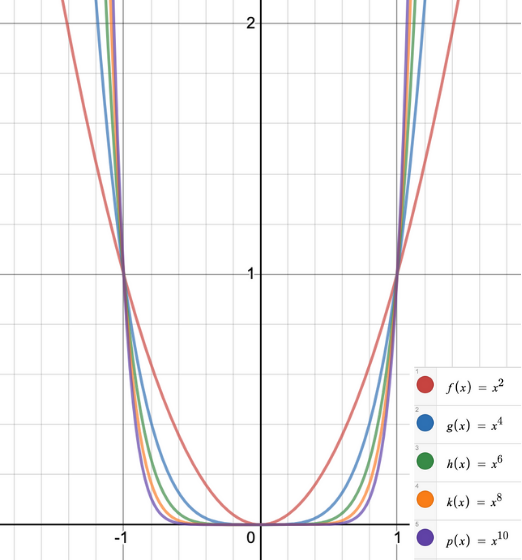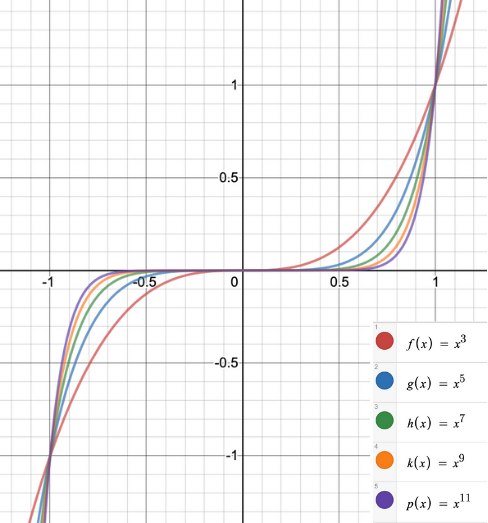Identifying End Behavior of Power Functions

The behavior of the graph of a function as the input values get very small ( [latex]x\to -\infty[/latex] ) and get very large ( [latex]x\to \infty[/latex] ) is referred to as the end behavior of the function. We can use words or symbols to describe end behavior. Let’s look at the graph of power functions with a non-negative integer exponent that has the form [latex]f(x) = ax^n[/latex] where [latex]n[/latex] is a non-negative integer ([latex]0, 1, 2, 3, ...[/latex]).
Even-Power Functions
The graph shows the graphs of [latex]h\left(x\right)={x}^{2},g\left(x\right)={x}^{4}[/latex], and [latex]f\left(x\right)={x}^{6}[/latex], which are all power functions with even, whole-number powers. Notice that these
graphs have similar shapes, very much like that of the quadratic function. However, as the power increases, the graphs flatten somewhat near the origin and become steeper away from the origin.
To describe the behavior as numbers become larger and larger, we use the idea of infinity. We use the symbol [latex]\infty[/latex] for positive infinity and [latex]-\infty[/latex] for negative infinity. When we say that “[latex]x[/latex] approaches infinity,” which can be symbolically written as [latex]x\to \infty[/latex], we are describing a behavior; we are saying that [latex]x[/latex] is increasing without bound.
even-power functions
With even-powered power functions, as the input increases or decreases without bound, the output values become very large, positive numbers.
Equivalently, we could describe this behavior by saying that as [latex]x[/latex] approaches positive or negative infinity, the [latex]f(x)[/latex] values increase without bound.
[latex]\text{as }x\to \pm \infty , f(x) \to \infty[/latex]

Odd-Power Functions
The graph shows [latex]f\left(x\right)={x}^{3},g\left(x\right)={x}^{5}, \text{ and } h\left(x\right)={x}^{7}[/latex], which are all power functions with odd, whole-number powers. Notice that these graphs look similar to the cubic function. As the power increases, the graphs flatten near the origin and become steeper away from the origin.
These examples illustrate that functions of the form [latex]f(x)={x}^{n}[/latex] reveal symmetry of one kind or another. First, in the even-powered power functions, we see that even functions of the form [latex]f(x)={x}^{n}\text{, }n\text{ even,}[/latex] are symmetric about the y-axis. In the odd-powered power functions, we see that odd functions of the form [latex]f\left(x\right)={x}^{n}\text{, }n\text{ odd,}[/latex] are symmetric about the origin.
odd-power functions
For these odd power functions, as [latex]x[/latex] approaches negative infinity, [latex]f\left(x\right)[/latex] decreases without bound. As [latex]x[/latex] approaches positive infinity, [latex]f(x)[/latex] increases without bound.
[latex]\begin{array}{c}\text{as } x\to -\infty , f(x) \to -\infty \\ \text{as } x\to \infty , f(x) \to \infty \end{array}[/latex]
| Even power | Odd power | |
|---|---|---|
|
Positive constant a > 0 |
 |
 |
| Negative constant
a < 0 |
 |
 |
